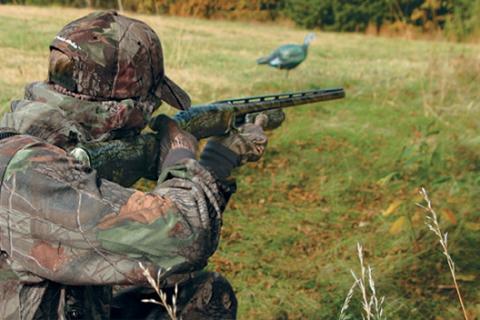

The following sequence occurs all too often on popular public hunting areas...
At dawn, a longbeard begins gobbling with anxious frequency. Several hunters hear him, race to the bird, surround him and initiate a calling contest. The turkey, abundantly aware that nature is not taking its course, flies down, shuts up and slips away, leaving the hunters frustrated by another failure.
Now, compare this with a second scenario wherein a lone hunter hears gobbling, takes his time in moving in and setting up, then issues a soft series of yelps and purrs. Ten minutes later this self-assured tom books his reservation in the roasting pan.
Obviously, the latter is the experience all hunters seek, and the surprise is that many can find it by claiming their "fringe benefits." This concept is both basic and accessible, and it can easily be employed by those wishing to broaden their hunting horizons.
Quite simply, "fringe" is the leading edge of a flock's expansion into new territory, and there is plenty of it. In the last decade wild turkey populations have spread like Bermuda grass in 49 of our 50 states. Today, thanks to aggressive stocking programs, these birds are thriving in areas where they haven't lived since frontier days — if ever. Their expansion should continue into the foreseeable future.
This means a lot of new territory is opening up each season, places where turkey numbers may not be as high as elsewhere, but also where no hunting has taken place. Gobblers in these virgin sites are as gullible as Little Red Riding Hood. Find them, and they can be had.
Don Wright of Hopkinsville, Kentucky, is a longtime turkey hunter who makes a habit of finding new fringe areas each season. He explains, "This is just a matter of doing some detective work to locate these areas, then scouting enough to pinpoint where the birds are working.
"By doing this each spring, I've managed to stay on the edge of turkeys spreading out in my area, and this keeps me a step ahead of most other hunters. The result has been a long string of birds that I've had all to myself."
Wright says the first step in locating fringe gobblers is contacting the state turkey biologist.
"Find out which counties opened up last season, and which are scheduled to open this spring. Also, ask the biologist for suggestions on areas where turkey numbers are low to moderate and where hunter pressure is also light."
In addition, Wright advises requesting a county-by-county breakdown of last year's harvest. Then they should study this list and a map for low-kill counties bordering high-kill counties. "Many hunters are drawn to areas where turkeys are thick and the bag is high, but so is the competition. In the process, they ignore adjacent places where turkey populations are lower but building. These 'sleepers' can be overlooked hotspots."
After identifying several likely fringe areas, Wright begins "serious-scouting" in them to find pockets of turkey habitation.
"This takes a lot of legwork. There aren't many shortcuts," he explains. "I start driving backroads at dawn, stopping every half-mile or so to listen for gobbling. Also, I check with anybody who might be able to steer me to turkeys. I call the local wildlife officer. I talk to farmers in country stores or on the side of the road. I check with school bus drivers, rural mail carriers, electric linemen, anybody who spends a lot of time outside and who may see a flock. Usually, information they give you is very reliable.
"But one source I don't pursue is other hunters," Wright notes wisely. "You won't learn any real secrets from people who love to hunt turkeys as much as you do."
Maps are a good way to organize informational tidbits. When a hunter begins scouting an area, he should also collect roadmaps, topographic maps, timber company charts and other maps which show backroads, streams, powerlines, railroad beds and other terrain features.
"When you're scouting, if you hear a turkey gobble or a farmer tells you where he's seen a flock, circle it on your map," Wright advises. "The harder you work at scouting, the more circles you'll have when opening day comes. Then you've got several options. If you don't hear a turkey gobble in one spot, you can move quickly to the next." Assuming, of course, you have permission to hunt there.
Wright always checks public areas: Reservoir boundaries, national and state forests, or timber company holdings open to the public. Still, private lands usually offer better hunting with less interference.
"I've always had good luck gaining permission from landowners in areas where hunting has just opened up," Wright notes. "Now, not all farmers welcome me with open arms, but some do. You never know until you ask. When I locate some birds, I seek out the landowner, and I'm courteous and straightforward in asking to hunt. I make it clear that I'll be the only one there. Many farmers don't mind granting permission if they feel like they're not going to be run over by hunters."
A serious pre-hunt scouting effort may turn up a half dozen good, accessible fringe areas, and this is sufficient for a banner season. One tom in the right spot is plenty for a thrill-packed morning, and it doesn't take many such mornings for a successful year.
Thus, locating and hunting "fringe benefit gobblers" is a simple matter of making the commitment to do so. Don't follow the pack. Stay ahead of it, and enjoy the benefits of your effort.
"It's a great feeling to uncover some turkeys no other hunter knows about," Wright summarizes. "You can take your time and hunt a gobbler the way you want to. It's just you and him, and if you mess up, you won't have anybody else to blame.
- 5557 views

